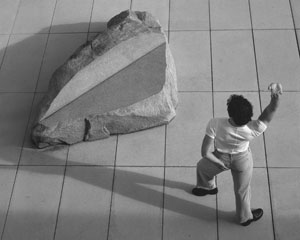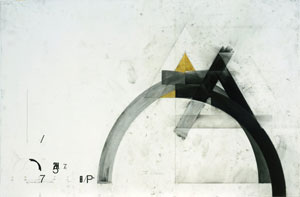What makes a photograph worth keeping? Is it something special—that special place, that special person, that special time?
True, the story goes, some collectors disdain photography as something anyone can do and too often does, before posting it online. Others, though, know just where to point and what to shoot on their way to the decisive moment. Sound awfully romantic? Edward Burtynsky goes that ideal one better. For fifty years now, he has been the first to think of not just what to shoot and what to print, but what to see. It could be somewhere that you could never reach or never wish to go. And he is in a hurry to get there, just in time for “The Great Acceleration,” at the International Center of Photography through September 28 (with a summer show at Howard Greenberg). 
Born in 1955, Burtynsky has been seemingly everywhere. He is not, though, nostalgic for any of it and not in the least romantic. He is mapping, ICP says, “human alteration of natural landscapes around the world,” in an age that some call the anthropocene—meaning people front and center, effacing the natural world and remaking the planet. If you are not altogether sure whether that alteration is a great or a terrible thing, neither is he. Together with Sheida Soleimani, a refugee from half the planet away also at ICP, he wrestles with a bittersweet future. He is not looking away and not looking back.
Burtynsky is out to see what no one has seen in more than one way, starting by just being there. He has seen ship breaking in Bangladesh and auto wrecking in Arizona. He has reached textile factories in China, oil fields in Azerbaijan, sawmills in Nigeria, and silver mines in Mexico. Humanity, he explains, has come out of Africa, and now it has come “full circle.” He sees what no one has seen as well because too many have refused to see it. These are things of huge commercial value but disdained as the very name of garbage, like salt deposits, uranium tailings, nickel spills, and what they lay to waste.
Above all, Edward Burtynsky sees what others cannot because of where he stands. The Canadian adopted a high vantage point, sometimes from digital cameras and helicopters, even before he took to drones, where no one at all is exactly doing the seeing. His technological prowess has only increased over the years, with such devices as gyroscopes to stabilize flight. He is documenting technological advances, if you wish to call them that, as well. It makes the surface of the earth his canvas, with painterly images, and do not even ask who is painting. They can be wildly expressive, like the free curves of rice terraces in Asia, or startlingly geometric, with long bands and concentric or overlapping circles.
The curator, David Campany, suggests the influence of Abstract Expressionism on the camera’s “all over” picture. John Chamberlain, after all, made expressive use of auto wrecks, too. Chamberlain helped to initiate a further change in art, too, toward the commercial objects of James Rosenquist and Pop Art. Burtynsky’s subjects include a positive riot of brand names in Pennsylvania—including McDonald’s, Starbucks, Exxon, and Walmart. They could be competing to claim the intersection as their own or the entire earth. It has, Campany adds, an “unsettling beauty.”
I started with a sentimental ideal, but neither I nor Burtynsky necessarily shares it, not any more. He is not Henri Cartier-Bresson this late in the day in search of that “decisive moment.” Rather, he gains in relevance for what many before Andy Warhol once disdained, repetition and reproduction. He is not above decisive places and events, like Mount St. Helens after eruption, but he prefers subjects that retain their anonymity, as a window onto the everyday. He sees industrial transformation as a transformation in society and in human lives. It could be the price of a so-called free market or, in China, an instrument of the state.
Burtynsky calls one series Natural Order, with obvious irony, but he may not have to choose between ideals—or between ideals and no ideal at all. He is demanding that people observe and take responsibility for what is lost while responding personally to an endangered beauty. He likes the landscape best at noon, he says, for the “confusion of shadows.” He loves detail, like tiny holes in the land that appear only up close, or a field of black rubber tires. He prints big and in diptychs, to leave you asking just what is at all natural. He makes it hard to identify the subject or point of view.
Sweeping curves could belong to a highway or to erosion from frighteningly toxic waste. A salt river blends easily into suburbia and farming into tailings. People find work creating waste, but also in cleaning up. Sharp color is irregular and rare. (Who would waste good money on color in a prefab development?) Yet it and so much else could pass for touch-ups after the fact from a painter with a gifted hand.
If this is the anthropocene, with people as its ends and means, what counts as human? By far the most photos are devoid of people—and that confusion, too is a fact of modern life. Burtynsky treats some scenes as portraits of industrial and post-industrial workers, in leisure moments and numbing labor. But landscapes are for him a kind of portrait all by themselves. Burtynsky allows himself few signs of pain and plenty of bombast, but he is fine with that. There is a tempting beauty in a confusion of shadows.
Read more, now in a feature-length article on this site.





